by Dick Jones | Contributing Editor
Specifications
Manufacturer: Just Right Carbines
Caliber: 9mm Luger
Action Type: Semi Auto, Blowback
Receiver: Steel, matte black finish
Barrel: 16”, threaded for suppressor
Magazine: 17 round polymer
Trigger: AR 15 service grade
Sights: Picatinny top
Stock: Telescoping 6-position collapsible M-4 style buttstock
Weight: 6.5 pounds
Overall Length: 32.5/36.5 inches
Accessories: Carry pack for takedown carry
Suggested Retail Price: $649
Website: justrightcarbines.com
According to statistics provided by Luckygunner.com, in 2013 their most popular ammunition by revenue generated was 9mm Luger. In fact, 9mm provided 21.4% of their total sales volume. I’m sure that in number of rounds fired, .22 Long Rifle is more popular, but in centerfire ammunition, 9mm Luger ruled the roost with more than twice the number of dollars spent than its nearest competitor, 5.56 NATO/.223 Remington.
There are multiple reasons for this: like the number of popular handguns in 9mm, the affordability, and the fact that 9mm is simply a fun caliber to shoot. With modern defensive ammunition the 9mm has the reputation as a reliable stopper, it’s accurate, there are a myriad of available loadings, and it’s clearly the cheapest centerfire caliber to shoot. Low cost 9mm gets close to the elevated prices often seen on .22 rimfire ammunition during the worst of the shortage created by liberal political saber rattling after the Sandy Hook incident.
With all those contributing factors, the popularity of 9mm carbines should have been evident, but it may have taken the industry by surprise. Now there are several 9mm carbines showing up and since United States Practical Shooting Association has opened up a new shooting venue for them as Pistol Caliber Carbine in USPSA pistol matches, it seemed a good idea to look into them. I’ve shot several AR 15 based 9mm carbines and talked to the owners. Most were happy, but all mentioned drawbacks.
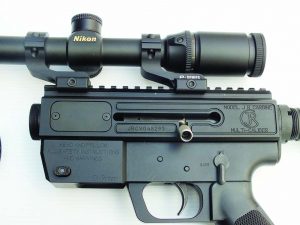
The magazine release is in the perfect location for a fast mag change with coupled magazines. The thumb would press the release while the fingers grasp the magazine and switch. The 1-4 Nikon was perfect for this carbine; the German reticle was fine enough at four-power to utilize the accuracy.
In thinking about this, I remembered seeing a 9mm carbine at SHOT Show that impressed me. At the time, I wasn’t thinking about it as a competition gun, but more as a low cost utility rifle that fired affordable ammunition. I called them up and they sent me a rifle, and I am thoroughly impressed. While the name, Just Right Carbine, sounds like a utility or camp gun and not like something for serious competition, I found the JR9 to be a remarkably impressive gun for almost any purpose.
While it’s available in both .45 ACP and .40 S&W, I chose the JR9 Takedown Model in 9mm Luger based on the advantage of low cost shooting. There’s also the advantage of more magazine capacity. I chose the takedown model because it’s the base model in the line at $649.00 MSRP. The JR9 uses readily available and inexpensive Glock 9mm magazines available in capacities from 10 rounds to 33. It uses a standard AR 15 fire control group, allowing the purchaser dozens—if not a hundred—different trigger choices. The M4 style stock and pistol grip is also shared with the AR 15 platform.
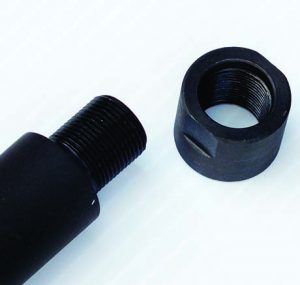
The muzzle is threaded and this would make a great suppressed gun. It would be subsonic with 147-grain 9mm.
The Just Right Takedown operates on the blowback principal, the simplest form of semi-automatic firearm operation. The charging handle can be switched from left to right side with the removal of a single hex screw. Ejection can also be switched from left to right; the ejection port has a cover that switches from the right to left side. Safety is standard AR, but the magazine release is on the left side of the magazine well, instead of the AR position, the cause of some consternation from purchasers, but more on this later. There’s no bolt holdback on the last round, but in all fairness, none of the 9mm carbines I’ve shot offer this. You can manually hold the bolt back by pulling it back and down, allowing the handle to drop into a vertical notch in the groove it reciprocates in.
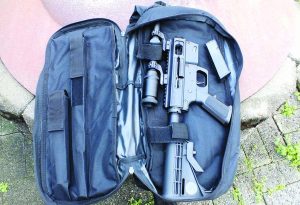
An option that adds just a few bucks to the price is an over the shoulder bag for the take down model. It’s a perfect storage solution for the perfect truck utility rifle.
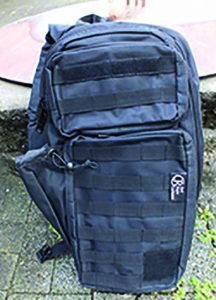 There’s a Picatinny rail on top of the receiver that’s long enough to allow forward mounting of optics with long eye relief. Takedown is accomplished by simply unscrewing the forend tube and sliding the barrel out of the receiver. The barrel is keyed to assure precision fit and it’s precise enough that I experienced no zero changes after removal and replacement. The Just Right Carbine is also convertible with kits for caliber change with an MSRP of $280. All this makes the JR9 Carbine one of the most modular of all firearms ever, with hundreds of triggers, stocks, pistol grips, and magazines available as well as three calibers; all this in a gun with an MSRP of just $649.
There’s a Picatinny rail on top of the receiver that’s long enough to allow forward mounting of optics with long eye relief. Takedown is accomplished by simply unscrewing the forend tube and sliding the barrel out of the receiver. The barrel is keyed to assure precision fit and it’s precise enough that I experienced no zero changes after removal and replacement. The Just Right Carbine is also convertible with kits for caliber change with an MSRP of $280. All this makes the JR9 Carbine one of the most modular of all firearms ever, with hundreds of triggers, stocks, pistol grips, and magazines available as well as three calibers; all this in a gun with an MSRP of just $649.
All this is impressive; however like ads on late night TV go, wait there’s more. Features mean nothing without performance. Based on reports from other users of 9mm carbines, I was not prepared for miracles, expecting mediocre accuracy and occasional functionality issues. What I got was nothing short of amazing. I certainly didn’t expect accuracy better than many rifles sold as competitive or even precision rifles and I certainly didn’t expect to run hundreds of rounds through it without a single malfunction. But that’s exactly what happened!
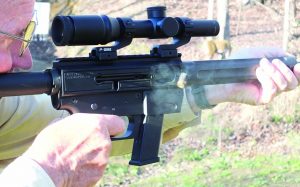
Shooting the JR9 is a blast. It’s quiet, but there’s enough recoil to let you know you aren’t shooting a rimfire. The great accuracy makes it fun and allows ringing steel far beyond what you’d expect from a 9mm.
First, the accuracy! I test a lot of rifles and true minute-of-angle accuracy isn’t as common as one might expect. Most reports of minute-of-angle accuracy involve three-shot groups and, given enough time, I can get a minute-of-angle three-shot group from an out-of-the-box AKS with steel case ammunition. As a former NRA High Power and Long Range Service Rifle shooter, I know real accuracy is tested with a minimum of five shots and better with ten. Not long ago, I tested two well-known precision rifles from a company known for accurate rifles. I tested them with several brands of match ammunition and neither averaged sub-MOA with either load. Imagine my surprise when I shot a five-shot, 50-yard group that measured just over a quarter-inch center to center from a take-down carbine in 9mm. My best group through the JP9 with Zero 115-grain, 9mm, measured just .261 and averaged .487 for five groups. Of course, this is also a testament to the accuracy of Zero ammunition, something competitive shooters have known for years. Shooting was done from a Caldwell Solo Sled with a Nikon M.223 3-12 x 42 scope.
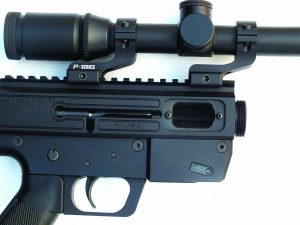
The screws in front of and behind the ejection port are for the cover should ejection be switched to left side. The magazine release must come from the right side because it uses the common Glock magazine, but switching to right side could be accomplished as it’s done with some AR-based pistol caliber carbines.
While Just Right advises against reloads and steel cased ammunition, being the rebel I am, I tested it with both. After accuracy testing with the Nikon M.223 3-12, I switched over to a 1-4 Nikon variable with the German reticle. I’m not fond of reflex or dot sights because they always have a ghost image for me and I don’t like sights that require batteries. Since a lightweight scope is a benefit on a 9mm carbine, I chose this scope because it only weighs 12 ounces. It has a simple no-nonsense reticle and I’m no fan of reticles so complicated you need a manual to understand them. I used the Nikon AR.223 two-piece mounts to further keep the weight down.
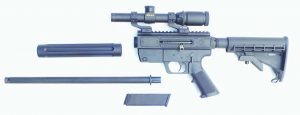
Takedown is accomplished by unscrewing the forend tube and sliding the barrel out. It takes just a few seconds. This is a remarkably simple firearm with far fewer moving parts than most.
The JR9 ran everything I put through it without fail, from powder puff match loads to fire breathing +P defensive ammunition. The trigger is standard rack grade AR. Recoil, as might be imagined, is light, but all 9mm carbines I’ve shot are bouncers compared to a tuned three-gun rifle. The JR was certainly no worse than any of the others and better than some. Recoil was a straight-line bounce that allowed double taps in close proximity. Fast magazine changes were hampered because the magazine release is on the left side of the gun and on my test gun, the magazine wouldn’t drop on its own. Coupling two 33-round Glock magazines would put the release in a great place for a switch since the thumb would be in the perfect spot when removing and reinserting. I liked the ambidextrous charging handle both for versatility and location. Much more convenient than an AR!
Maybe the best part is the potential for the JR9. I plan to upgrade the trigger, couple two 33-round Glock magazines and shoot my local club’s carbine/pistol match. For USPSA competition, coupled magazines aren’t allowed, so the left side magazine release will be a disadvantage. AR platform rifles using Glock magazines get around this problem with a seesaw lever release that allows dropping the magazine from the standard AR location. This would be a fairly simple conversion and one I’d like to see JR offer as an option or upgrade kit. The best part is I found it online for just over $600, less than half the price of many AR based 9mms. I’m not certain there are better 9mm carbines, but if there are, I’ll bet they’re twice the price or more. Perhaps this gun might be more attractive to some with a more aggressive or tactical name like the Spec-Ops JR9. Fact is, I found the name described it pretty well.



